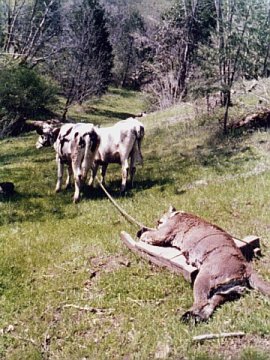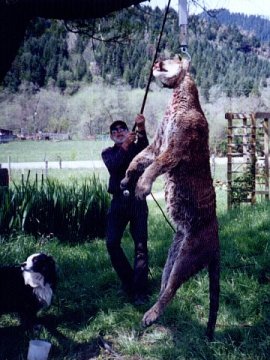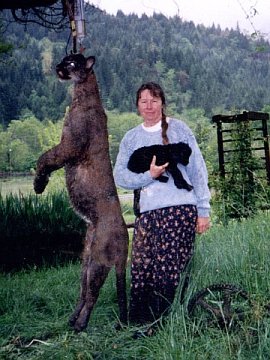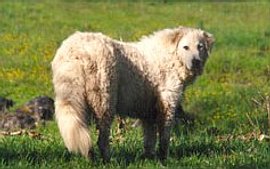~~* The Year of the Cat *~~
(Reprint of article published in SMALL FARMER'S JOURNAL, a quarterly publication.) Summer 1997
Ours is a goat ranch. We have 77 acres in the precipitous Cascade mountain range of southern Oregon. We're lucky enough to have 40 of that as treeless pasture land, historically used first by the Cow Creek Indians in the 1800's as grazing land, and in modern times (1930's) as oat fields. Neighbors who have been around these parts from the time of antiquity say that those oats were gathered with draft horses. One guy in the 70's was still doing it in our back forty.![]()
My husband and I want to grow oats again on those fields, but we'll farm with a team of oxen when we do. Bright and Tears are two and one half-year-old Holsteins at the time of this writing. My husband works them daily (hauling stones to the herb garden – [we're talking BIG stones], bringing firewood or bringing in the logs for a future timber frame barn.) He is very proud of them, and if you ask him about them, he'll probably grin a country grin and say, "They're good boys."![]()
My story, though it involves the oxen, is mostly written in relation to our goats. We breed angora goats for the mohair fiber they produce. I'm a handspinner and weaver, and though we have a few sheep, I concentrate on producing products on my loom with 100% mohair fibre.![]()
We have about 15 does and 3 bucks at this time.** If anyone out there is familiar with the "fibre industry", just as in sheep the handspinners began to covet the black sheep for its innovative wool colors, the angora goat breeders have only just recently begun to concentrate on raising goats of "color." The main colors in a wide array of hues are varied shades of black/silver, varied shades of what they call "red" (almond to deep, rich beige) and finally, "Moorit" – a distinctive chocolate brown color. The "reds" and "moorits" probably overlap, but for a handspinner and weaver like me the spectrum of colors these goats come in is a dazzling and wonderful sight. (I must admit that there are times I see ladies with perms in their hair that make me want to grab a big handful off of their heads and spin away – imagine how much more my hands long to spin the curly mohair off of an angora goat, loaded with tightly twisted tendrils!)![]()
Our herd has been allowed to range freely in our meadows. We have not yet "cross fenced" or planted pasture, but have used a "hand cranked" seeder and planted our share of sub-clover species and other grasses over that large, flat pasture. Every spring more and more is seen. More often than not, they take to the woods in the back forty, for goats love brush, berries and browse. They are known, technically, as "browsers"; a field of clover really doesn't interest them for long. (And forget the tin cans – that's an old wives' tale. They are meticulous about their food. If another goat so much as "steps" on their mound of hay once, it goes uneaten.)![]()
It was May 1996 and the fields and forests were green with new spring growth. When the goats came back early that day, on the run, with two missing (a doe and a young doeling three months of age), we knew right away something was wrong. Stan combed the woods where their "footprints" showed they had last been, an area just outside our open pasture wooded with madrone and evergreens and a lot of debris still lying on the ground from a logging job accomplished a couple of years ago. It's dense, dark forest in that area, shaded and cool.![]()

The oxen pull their peculiar burden as Stan looks on wondering if this will ease the tragedy of the farm's losses.
The old timers across the street, here since '47, said, "Stan – keep on a'lookin'. If you have two goats missing, you're bound to find sign if you just keep on a'lookin'." So, taking their sage advice, he scouted until he found the cat piles – two of them – with the freshly laid remains still under them.![]()
The big city people in Portland and Eugene make up our laws around here (since there's a lot more of them than us ranchers), and they had voted in a law that says we can't hunt cougars anymore with dogs. That's the only way you can really get a cougar – tree ‘em with hound dogs. So, we decided to be "legal" about it all (no "S, S & S here) and called the Fish & Game. They said we could call out the dogs, since we had an "official" cat scrape with the remains of our fibered animals in those piles.![]()
The dogs' owner (Tim O'Leary) told us to leave the remains within the scrapes. He came out the following morning with Bodacious ("Bodie"), head of the surly pack, and the rest of the hounds. Sure enough, the cat was hungry for leftovers. Tim's hounds picked up the scent right away. Within minutes they had run across our property to a large upright tree and had treed the cougar. He was a "collared" male (in Oregon the state radio collars the cats so that they can keep track of them). He'd even been named by the state: "Turbo". Turbo was a 4 year old tom, second largest known to be in the area, they said. He was 7'4" long (from nose to tip of tail) and weighed 163 pounds (see photo).![]()
After Stan shot the cat he told Tim O'Leary that he would get his stone boat and the oxen would drag the cat back to the house. The old timers across the street said, "Your oxen aren't going to drag that cat in. They know the scent of cougar. You ain't gonna get them to come NEAR THAT THANG!"![]()
But, Bright and Tears were courageous and obedient, as usual. They gallantly pulled that big cat home (their eyes bulging at times with apparent respect of their strange "load"). Not once did they balk or show the promise of bolting, which is what we were told they would do.![]()

Here is the first large tom being weighed by the houndsman, for state records. He weighed in at 163 lbs.
This area is laced with cougars. In 1995 eleven full-grown cougars were known to have been "relocated" to Tiller, Oregon, the mountainous region where we live, by state officials whose duty it is to protect the catamount. There have been no recorded human fatalities yet due to the predator catamount, but realistically that kind of track record will have to someday soon be marred. There are too many of the big felines around; even the government officials in charge of monitoring and protecting them have admitted that over and over again.![]()
We keep the goats enclosed nowadays. They don't get to range freely anymore. That's a drain on the pocketbook because we're constantly buying hay. But, after all, it's our business, and we were tired of having the profits of our home business being "eaten away." Quite literally, eaten away.
catland2.jpg (29656 bytes)![]()
ADDENDUM TO THE ABOVE ARTICLE:
1996 turned out to be a devastating year with the loss of over half of our angora goat herd and half of our family flock of sheep - all to mountain lions. We had purchased a young champion buck with none to spare of our lean homestead budget. He fell prey to the ravages of a lion also. (Alexandra writes of the emotional sojourn she took on the heels of "Seed's" death in another yet unprinted article entitled "Seed - Goat of Promise").![]()
Soon after, a lamb ewe of the sheep was taken as it sought refuge near the house! It broke us. You cannot imagine the heart break and heavy concern we have lived under. We are not lion hunters. We are shepherds and crafters. The capturing and killing of these animals has been very difficult to bear. The last we have heard from the state is that the catamounts were not "planted" in the area but were collared from the indigenous population.![]()

Here you can see the relative size of the puma as it is being weighed in relation to the size of both a kid goat and to Alexandra. The feline was 7 feet 2 inches in length and weighed 135 lbs. This was another Tom that ravaged the herd.
As of this writing there are 38 known collared felines in an ecological zone large enough to support a half dozen puma. We acquired a Kuvasz guardian dog in late October 1997 as a pup of 13 weeks. He has since grown up to be a mighty and fierce protector of our flock. We are proud to announce we have had no more losses to cougars (other than two lambs taken when Uzi was only five months of age, still penned at the time of the lion kill.) We were relieved, actually, that Uzi had been penned that ill fated morning. Had he been loose, I'm sure he would have attempted to defend the lambs though he was but a pup. That lion turned out to be an uncollared hungry tom 7 feet 2 inches in length, weighing in at 135 lbs. Stan ended up successfully trapping the lion the following morning, near the carcasses of the bottle fed lambs the tom had buried. (See photo below).![]()
Our strategy has been as simple as the shepherding/crafting lifestyle we have chosen to live. First, we prayed diligently. We studied the situation carefully. The end result has been a proactive program of intense shepherding, obtaining the Kuvasz guardian dog, and extensive fencing. Leaning on God, we seem to be beating the odds. It's called in the vernacular, "learning the hard way."![]()
Last winter Stan and a close friend and fellow shepherd went to Salem, the Oregon State capitol and testified before the House of Representatives Committee on Wildlife Resources. The meeting was long with every side of the issue clearly represented. It was amazing to see all of the political maneuvering and the heartfelt opinions being expressed. One of the most impressive testimonies was from the Oregon Department of Fish and Wildlife. Apparently the ungulate populations (deer, elk, antelope etc.) in the northeastern and southwestern portions of the state are being decimated to the point of creating serious imbalances in the wilds. Human encounters with mountain lions is on an unprecedented rise. The current laws (a product of modern public opinion) have virtually tied the hands of the ODFW in terms of managing the felines for the health of the wilds. But when push comes to shove it's the non predatory animals and the homesteader/rancher who carry the weight of a large, hungry lion population. To be sure, the overpopulation of puma in this area is going to contribute to the ongoing burden of managing our homestead. The present method, however, is working, and for this we are thankful.
![]()
** Author's Notation. It is now September 1999. If all goes well and the does that we bred this season kid normally, we should have a herd of at least 30 angora goats by Spring 2000.
For those interested in practical horse farming, training oxen, general "homestead" knowledge, I know of no better publication than the SMALL FARMERS' JOURNAL. You can subscribe to this publication by writing them at 325 Barclay Way, Sisters, Oregon 97759.![]()

Uzi means "Guardian". Thanks for your help, boy!
 †
†
Alexandra Scribe
Homestead Home
TOP






